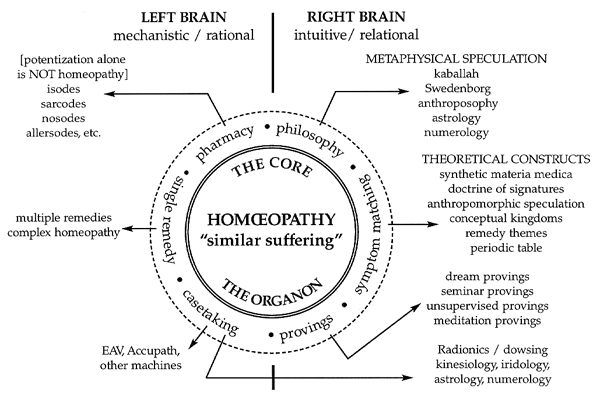
After much debate with others as to "what is homeopathy and what is not homeopathy" I began to build a visual model of my thinking.
What is homeopathy? How do we define it? How can we understand its borders? Can we build a model?
The word "homeopathy" describes the system that Samuel Hahnemann developed. It has to do with "similar suffering"— that we know what a substance can be used for curatively, because we have seen what symptoms that substance can produce in a healthy person. The full system is described in his work, The Organon of the Healing Art. This is the core of homeopathy. Around the core are the other parts which make up the whole: the principles by which we operate, the necessity of the proving, the exactness of case taking, the need for accurate symptom matching, the importance of giving the single remedy, and the pharmacy process needed to create that remedy.
Each of these parts has been expanded upon throughout the history of homeopathy. The question of "is it homeopathy or is it not?" depends on the extent and the direction in which these parts have been expanded.
In my visual construct, the outside edge that constrains homeopathy is seen as a dotted line surrounding the above parts. It is dotted because it is not quite fixed— it is slightly moveable and often blurry.
While constructing this visual model I also realized that those parts which support a deviation from "homeopathy" fall into two basic areas: those that are "Left-brained" where the emphasis is on rational thinking and mechanistic models, and those that are "right brained" and work from an intuitive and relational base.
The "deviations" can take place very close to the edge, or very far from it. As an example, we can look at pharmacy. Samuel Swan, MD, in the 1880s, created a series of nosodes (remedies made from diseased product)— Medorrhinum (from gonorrhea), Tuberculinum (from tubercular tissue), and Syphilinum (from the syphilitic chancre). These substance then underwent provings thus bringing them into the homeopathic circle. They were used, and their use was reported in the literature. Now, 120 years later, is the use of them "homeopathic"?
The answer is, "well, that depends..." If they are used according to the proving symptoms they elicited, yes. If one gives Medorrhinum only because there might be a history of gonorrhea in the family, and does not prescribe upon the exact similitude, well... we are looking at it through some possible clinical verification but we are a bit outside the ring. If one prescribes it routinely based on the idea that "all westerners have gonorrhea in their past" (something I once heard a homeopath say in justification for his prescription) then we are way outside the ring.
So... where outside the ring does the action fall? Please understand that I am looking at this diagram for definition purposes only. I am not saying that those things outside of the ring are not useful in practice and/or they might not be curative. I am simply trying to locate it all in relation to the grounded material that IS homeopathy. An unsupervised proving might establish quality information about an unknown remedy. As such it can be seen as close to the outside edge. Whereas a seminar proving where a dose is given to all at a seminar, and all the participant (whether they took the remedy or not) are asked to write about what they felt during the two days... such a proving is way outside the grounded circle.
Perhaps we can all use the visual construct to place ourselves within the context of homeopathy, and to note what our deviations are and when.
